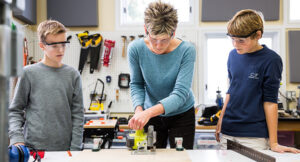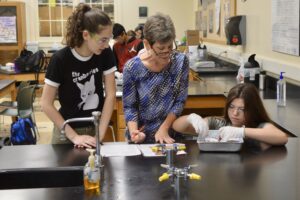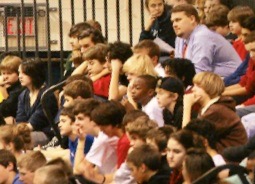Karen Glum

I remember being a young teacher at Seven Hills, and former Middle School P.E. teacher Beth Leonard was receiving a recognition for hitting a milestone number of years teaching at the school. At the time, I thought, “I don’t think I could stay in the same place for even five years.” Here I am almost 30 years later. It speaks to how our school keeps things fresh and stimulating, not just for the students, but also for the teachers. At so many schools, that isn’t the case. Seven Hills has let me remain a student as much as a teacher.
After teaching biology, chemistry, and environmental science in Middle and Upper School, about eight years ago, Bill Waskowitz tapped me to teach a course for seventh graders, where the initial idea was that maybe students would invent something. It evolved from there, with me saying, “I need a dedicated room for this, I need all these different materials.” The idea continued to grow and ultimately turned into the Innovation Lab, which I led starting at its inception.

In the beginning, the Innovation Lab was mostly just a room where students could build or take things apart at lunch, and where parents would come in to do special engineering activities with the students. Over time, it grew to cover all three Middle School grades. Now, sixth graders take a class called introduction to innovation lab, seventh graders take exploring engineering and design, and eighth graders take exploring computer science.
One of my favorite projects, which we would do with the sixth graders, is called puzzles for a purpose. The students would make puzzles for other people, which some years we would donate to the Alzheimer’s Association. I loved that project because it pulled so many different learnings together. The students learned to use tools like scroll saws and nail guns. They learned about Alzheimer’s and neurons and the brain. And then they also learned about empathy-based thinking and design. We would talk as a class about perspectives and whose perspectives are important and what kind of things would you think about when designing for someone with Alzheimer’s, puzzle piece size and shape, and what images would you include and why.
In seventh grade, students in the Innovation Lab do more engineering challenges, while still practicing empathy-based thinking in design. Students would build dog showers, which might sound like a silly project, but it required a surprising amount of problem-solving. For that one, our “clients” were faculty members with dogs, whom the students would interview to develop empathy with their client, and then design the product to incorporate the clients’ wants and needs.

In eighth grade, as students learn about functions, loops, variables, and conditionals in computer science, they program these little softball-sized robots for the first part of the semester, and, by the end of the year, they’re building and designing their own robots.
The students learn and grow so much. I remember one sixth grade girl telling me about how her mom was trying to drill something at home, but it wasn’t working, and the little girl said, “Don’t worry, mom, I’ve got this!” because of what she’d learned in the Innovation Lab. I remember another pair of students who built and designed their own pinball machine using a 3D printer and coding all of the various lights and sounds — a really impressive feat of engineering.
During the years I’ve been at the school, we’ve seen a big increase in our focus on STEM education. When I started teaching here, we barely had computers. A big part of what the Innovation Lab tries to accomplish is to give students a sense of agency, especially technological agency. We live in such a different world now, and if students don’t have an understanding of these massive changes and the technologies behind those changes, they’re going to feel like they don’t have much control and can’t make informed decisions. The Innovation Lab also reaches a subset of students where more traditional academic classes might not be their thing, but you watch them in this engineering and design setting, and you’re floored by the things they can do.

I’ve always been struck by how much freedom students and teachers have here. That freedom breeds trust, which manifests itself as a closeness, almost a collegiality, between teachers and students. When I was a student decades ago, we walked from room to room in orderly lines and kept quiet. At Seven Hills, the attitude is, “We trust you; we trust you to get from here to there; we trust you to do the right thing.”
The freedom is not just for the students but also for the faculty. I’m given these courses and told, “Go teach!” That’s amazing. I’ve had the academic freedom to design courses, to choose what and how to teach, and it allows us as teachers to be so responsive to the students and what they need and what they’re interested in and how things need to be paced. That translates into the students feeling like the teachers are really in it for them.

Being a parent here when my two sons, Elliot and Michael, were students has also been such a gift. Elliot graduated in 2016 and his historical and emotional ties to the school run deep. He attended his first prom at six months old when I was chaperoning, and after being a lifer, he works at the school to this day, developing and running summer camps and the Counselor in Training program, and leading After The Bell for Middle School. Around campus, I am more often introduced as “Elliot’s mom” than as “Mrs. Glum.”
Michael graduated from the school in 2019, and there was a group of boys in his class, many of whom had been together since kindergarten and played basketball together for years. I’ll always remember sitting in the stands as a parent when they were in high school and watching these boys have their arms around each other every game for the whole game. They had this amazing, visible love for each other that still gives me chills picturing it.

Michael was on the basketball team, and he didn’t get a ton of playing time but loved being part of the group. His senior year, in the last game, every other senior had scored, and they put Michael in. He ended up making a buzzer-beater, and the cheering section was screaming and going crazy, and his teammates, this brotherhood of friends, were all bouncing up and down like bunnies. That moment showed me who those boys were, who our students are, and what our school is about — it’s not about one, it’s about all.

